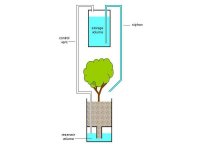Pros and Cons of 24/0 VS 18/6
24-2=
22-2=
20-2=
18....
more light=potential more made & stored energy. directing the energy to flowers when finally dark come...maybe...
@ cactusjack...
similar to automatic pet waterer config ...
...
imaginary planty seem like top water 1-2 tymes per week. even if sub-irrigated.
maybe large trough & feed every other day, if want 1 large res.... the run-off from day 1 used thru day 3, when more solution poured, esp if use wick.
if use buckets, square 4 gal fit into round 5 gal, neat. wick in 4, down into 5...

24-2=
22-2=
20-2=
18....
more light=potential more made & stored energy. directing the energy to flowers when finally dark come...maybe...
@ cactusjack...
similar to automatic pet waterer config
imaginary planty seem like top water 1-2 tymes per week. even if sub-irrigated.
maybe large trough & feed every other day, if want 1 large res.... the run-off from day 1 used thru day 3, when more solution poured, esp if use wick.
if use buckets, square 4 gal fit into round 5 gal, neat. wick in 4, down into 5...




